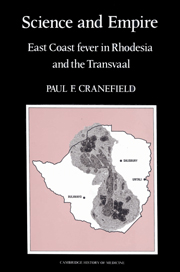Book contents
- Frontmatter
- Contents
- List of illustrations
- Preface
- Acknowledgments
- 1 Prologue
- 2 The places and the players
- 3 A new disease?
- 4 The search for an expert
- 5 Robert Koch in Bulawayo
- 6 Joseph Chamberlain
- 7 Arnold Theiler, Charles Lounsbury and Duncan Hutcheon
- 8 The fight against East Coast fever
- 9 The African-owned cattle in Rhodesia
- 10 Two more parasites and another new disease
- 11 What is East Coast fever?
- 12 Epilogue
- Notes and references
- Index
9 - The African-owned cattle in Rhodesia
Published online by Cambridge University Press: 19 January 2010
- Frontmatter
- Contents
- List of illustrations
- Preface
- Acknowledgments
- 1 Prologue
- 2 The places and the players
- 3 A new disease?
- 4 The search for an expert
- 5 Robert Koch in Bulawayo
- 6 Joseph Chamberlain
- 7 Arnold Theiler, Charles Lounsbury and Duncan Hutcheon
- 8 The fight against East Coast fever
- 9 The African-owned cattle in Rhodesia
- 10 Two more parasites and another new disease
- 11 What is East Coast fever?
- 12 Epilogue
- Notes and references
- Index
Summary
The terms “native cattle” and “European cattle,” as used in early reports, had, perhaps unintentionally, a double meaning. “Native cattle” meant the cattle owned by the African peoples of the country, but those herds were also made up of strains of cattle that had been in the country for many years. The “European cattle” were not only owned by the European settlers, they were, by and large, made up of imported strains.
The fate of the African-owned cattle concerns us for many reasons. The killing of the African-owned cattle during the outbreak of rinderpest unquestionably contributed to the uprising of 1896, and memories of that uprising led to fears that the appearance of a new lethal disease of cattle might provoke another uprising. Secondly, it concerns us because of the often expressed fear that, once the disease had invaded the African-owned cattle, those cattle would become a permanent and ineradicable reservoir of infection because of the insistence of the Africans on moving cattle when and where they would. And it concerns us because of the great importance of cattle to the Africans not only because cattle were a store of wealth but because the ownership of cattle was woven into the very fabric of their society.
The fear of an uprising provoked by the death of cattle was to last for a long time.
- Type
- Chapter
- Information
- Science and EmpireEast Coast Fever in Rhodesia and the Transvaal, pp. 223 - 238Publisher: Cambridge University PressPrint publication year: 1991



